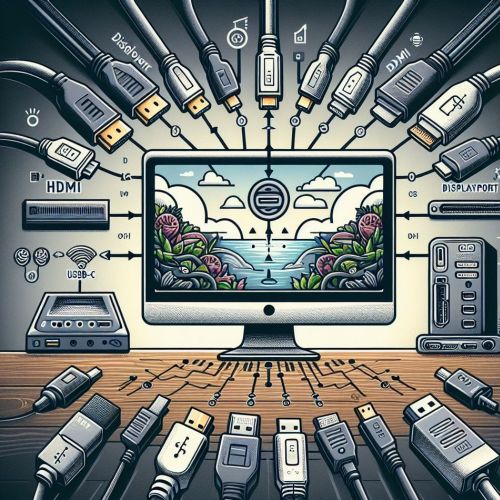Right Cable for Computer |
|
To connect your monitor to your computer, you can use several different cables depending on the available ports and the desired quality of the image and sound. The most common options are: HDMI cable: HDMI is a common and user-friendly option that supports both audio and video in the same cable. Most modern monitors and computers have HDMI ports. DisplayPort cable: DisplayPort is another common option that provides high resolution and audio transport in the same cable. It is often used in modern computers and monitors. USB-C cable: If your computer has a USB-C port, you can use it to connect the monitor, especially if the monitor also has a USB-C input. USB-C also supports video and audio transmission. DVI cable: Although DVI connectors are less common in modern devices, they can still be useful for older monitors or computers that support this connector. Choose the cable based on the types of connectors available on your monitor and computer, as well as the required quality of the image and sound. HOW DO THESE DISPLAY CONNECTORS DIFFER FROM EACH OTHER? If you've ever confused VGA and DVI connectors or been puzzled by their uses, you're not alone. In this guide, we explain how different connectors work and what they're used for, so you can choose the right connector for your needs.
ARE MONITORS AND COMPUTERS COMPATIBLE WITH EACH OTHER? Before choosing a display connector, check if your monitor has a connector that matches your computer's graphics card. It is recommended that the monitor supports at least 1920x1080 Full HD resolution, which can be found in the technical specifications of the monitor. DisplayPort vs. HDMI: Comparison DisplayPort and HDMI are both excellent display connector options, but they have their own strengths and weaknesses, and one is not generally better than the other. Here's a comparison between the two: Resolution and refresh rate: DisplayPort: DisplayPort supports higher resolutions and refresh rates compared to HDMI. For example, DisplayPort 1.4 and newer versions enable 8K resolution and high refresh rates. HDMI: The latest HDMI standards, such as HDMI 2.1, also support high resolutions and refresh rates, but may not be as high as DisplayPort. Connecting multiple monitors: DisplayPort: DisplayPort allows daisy-chaining multiple monitors through a single connector, making it easier to set up multiple monitors. HDMI: HDMI also supports using multiple monitors, but usually requires a separate connector for each monitor. Audio transport: DisplayPort: DisplayPort also supports high-quality audio transport in the same cable as video. HDMI: HDMI carries both video and audio in the same cable. Compatibility: DisplayPort: DisplayPort is common in graphics cards and many modern monitors, but may be less common in TVs and home entertainment devices. HDMI: HDMI is very common and widely used in TVs, projectors, and home entertainment devices. Price and availability: DisplayPort: DisplayPort cables and connectors may be slightly more expensive than HDMI counterparts, but the price difference is usually not significant. HDMI: HDMI cables and connectors are usually readily available and affordable. In summary, DisplayPort often offers better performance and versatility for higher resolutions and refresh rates, while HDMI is more common and convenient for home entertainment devices and TVs. The choice depends on your usage and needs. |


